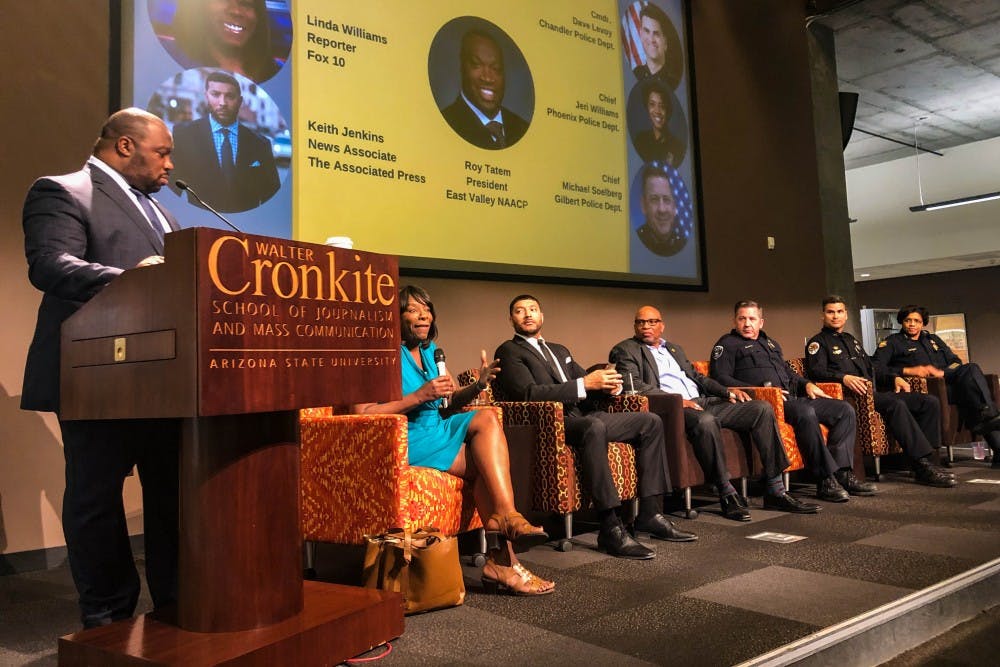In light of conflicts concerning bias in media coverage and police work, law enforcement and newsroom communities are working to promote awareness while also working to change the narrative.
The National Association of Black Journalists ASU chapter hosted a presentation involving law enforcement and media professionals on Wednesday evening at ASU's downtown Phoenix campus at the Cronkite building to discuss news distribution, body-cam footage and the media coverage of police brutality.
Media members and police officers from around the Valley participated in the event. Throughout the discussion, one concept was consistent: personal bias.
With increasing coverage on police misconduct but limited statistics to back up an increase in police brutality, the media has played a significant role in increasing awareness across the nation. However, that coverage can play into an agenda of its own.
While some police shootings gain tremendous traction in the media, others fade from Twitter feeds within hours. This is often influenced by media coverage that favors a victim narrative, some media analysts suggest. Outside of the newsroom, bias plays a role in law enforcement as well.
Phoenix Police Department Chief Jeri Williams said it's not uncommon for people to call in "suspicious activity" based primarily on skin color.
“I think it’s a societal issue – I would love it not to be an issue, but it is,” she said. “We all know it is, and it would be nice to look past that, I just don’t know how successful that would be at this point in time.”
The use of race in the media was also discussed at the event, and it can be either left out when relevant or unnecessarily added to fit narratives. The journalists on the panel agreed that having a diverse newsroom can help in deciding whether or not it is appropriate and relevant to include race in a story.
A 2018 Pew Research study concluded newsroom employees are less diverse than other workers in the U.S., as newsroom employees are more likely to be white and male.
Micah Bledsoe, a graduate student studying mass communication and an NABJ member, said bias is something she hopes to overcome in her journalism career.
"I've grown up in mostly white neighborhoods, and some of the experience I've indirectly had through friends and family members — it can come off that police are bad and the media is supposed to tell those stories," Bledsoe said. "Part of the reason why I want to get involved in journalism is to be a voice to tell both sides at the same time."
She said that bias isn't just seen in police actions, it is also seen in news stations and other media outlets as well. This commonality between the media and police was part of the reason she thought the discussion was so important.
"Depending on what news outlet you rely on, you can feel as if media is portraying an idea of the police, but what's really important is that we understand how they work together," Bledsoe said.
The panel discussed different methods of getting reliable information to the public, despite the fact that journalists are allowed to speculate while they gather information, but police cannot.
The speakers agreed though the two groups have several different communication methods and standards, being open to creating trusting relationships between media and police is crucial.
Dave Levoy, commmander of the Chandler Police Department, said one of the most important things law enforcement can do to address and change bias is to increase and improve training for officers.
He also said establishing new, positive relationships between communities of color and police could assist in lessening the bias.
"The first interaction I had with someone with a different background was in the military, where I met some of the greatest men I've met," Leroy said. "It's all about the interactions you have with people, and creating those interaction opportunities is really important to us."
Reach the reporter at kreinha3@asu.edu and follow @ReinhartKatelyn on Twitter.
Like The State Press on Facebook and follow @statepress on Twitter.




